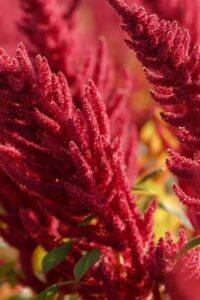Browntop millet, scientifically known as Urochloa ramosa, is a warm-season grass from the Poaceae family. It is widely grown for its nutritious seeds, which are used to feed both humans and livestock.Millets are small-grained grasses grown globally as cereal crops or grains for fodder and human use. Small millets are widely grown globally, covering 31.24 million hectares and producing 28.46 million tons each year. India is a major contributor to millet production, with a record 11.56 million tons produced in 2017 across 9.1 million hectares.
In India, it is commonly grown for grain and pasture purposes. It is also used as a nurse crop, particularly on slopes, to help with the establishment of a perennial crop. Traditional healers use the ash from the leaves to treat cardiovascular diseases, duodenal ulcers, hyperglycemia, nephritis, and snake bites. Browntop millet (BTM) (Urochloa ramosa; Panicum ramosum L.; Brachiaria ramosa L. Stapf) is valuable small millet with high yield potential in resource-poor and fragile ecological conditions, ensuring economic and nutritional security and sustainability for small farmers
Browntop millet (BTM) has yet to be recognized in the gazette. Brown millets include a variety of phytochemicals that promote health, including polyphenols, lignans, phytosterols, phyto-oestrogens, phytocyanins, phenolic compounds, tannis, and flavonoids such as anthocyanins, carotenoids, and tocopherols. Natural antioxidants protect the phospholipid membranes of the heart, neurons, muscles, and red blood cells from free radicals, preventing carcinogenesis and aging. Carotenoids can prevent cardiovascular illnesses, including atherosclerosis, preserve immune system function, and protect the retina of the eyes. These also act as immunological modulators and detoxifiers. BTM contains phytochemicals that can lessen the incidence of stomach ulcers and colon cancer.
Kingdom: Plantae
Order: Poales
Family: Poaceae
Genus: Urochloa
Species: ramosa

- Vernacular Name: Dixie singnalgrass and Hindi name andua.
- Origin: Browntop millet (Urochloa ramose L.), also known as ‘korale’ or ‘karlakki’ in Karnataka and ‘andakorra’ in Andhra Pradesh, is an underutilized millet that is often overlooked in monocrop agriculture systems. It originated in Southeast Asia and is now grown in Africa, Western Asia, Arabia, China, and Australia.
- Plant parts: Browntop millet (Urochloa ramosa) is an annual or perennial warm-season grass that is commonly utilized in forage and pasture management systems. The stem (culm) can be erect or prostrate on the ground. At maturity, it can grow up to 3 feet tall. Nodes will appear slightly hairy. The lance-shaped, hairless leafblades measure ¾-10 inches (2-25 cm) long and 1/8-½ inch (4-14 mm) broad. The inflorescence is ambiguous, open, and spreading. It has a simple axis and stalked flowers. It has 3–15 inflorescences measuring ⅓–3 inches (1–8 cm) from the central axis. The plant produces white flowers and tan ellipsoid seeds. It has fibrous roots that can grow up to 2 feet deep.
- Geographical area: Browntop millet, an imported grass, originated in Southeast Asia. It is cultivated in Africa, Western Asia, Arabia, China, and Australia. In the United States, it is mostly farmed in the Southeast for hay, pasture, and game bird feed. Browntop generally grows from 0.6 to 1.5 meters tall. Browntop millet is commonly grown in Karnataka, Tamil Nadu, Andhra Pradesh, and the Bundelkhand region of north-central India. Browntop millet, despite its high nutritional potential, storage stability, and fodder quality, is not widely grown in these states. Browntop millet is mostly farmed in Karnataka’s Tumakur, Chitradurga, Chikkaballapur, and Mandya districts, as well as Andhra Pradesh’s Ananthapur district, for traditional culinary preparation.
- Functional properties:
- Used for food: Browntop millet is a versatile crop with multiple uses, including food for humans, forage for birds, and raw material for industries. In India and Africa, tiny millets are consumed whole or ground into flour. BTM can be used to produce a wide range of foods. Its grains are used to make nine traditional southern Indian dishes: anna, dosai, kheer, nuchina mudda, roti, nippattu, chakkulli, haralu, kodubale, and kadabuappe. Browntop millet can be processed into flour for flatbreads like roti or dosa, or polished and boiled for gruel (kheer).
- Health benefits: BTM contains 12.5 g of fiber per 100 grams. Fiber aids in detoxification by eliminating waste from the colon. Fiber ferments in the colon and serves as a prebiotic. BTM’s high fiber content can help prevent and manage lifestyle-related disorders like constipation, diverticulosis, dyslipidemia, and metabolic syndrome. BTM has a good number of minerals. The magnesium content is high, at 94.5 mg/100 g. Magnesium helps insulin and glucose receptors function better by supporting carbohydrate digestion enzymes that regulate insulin action.


